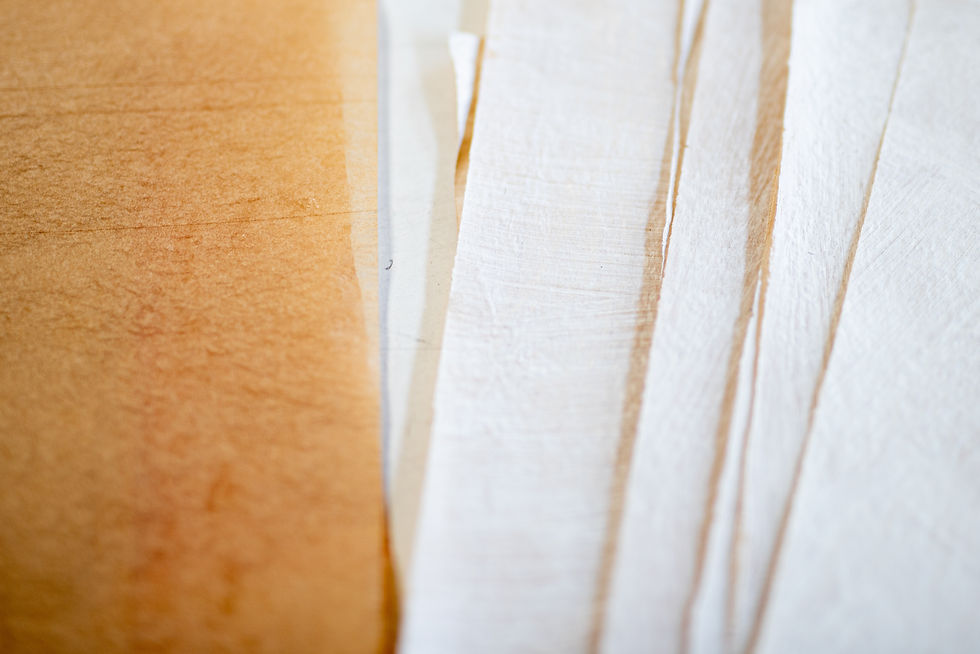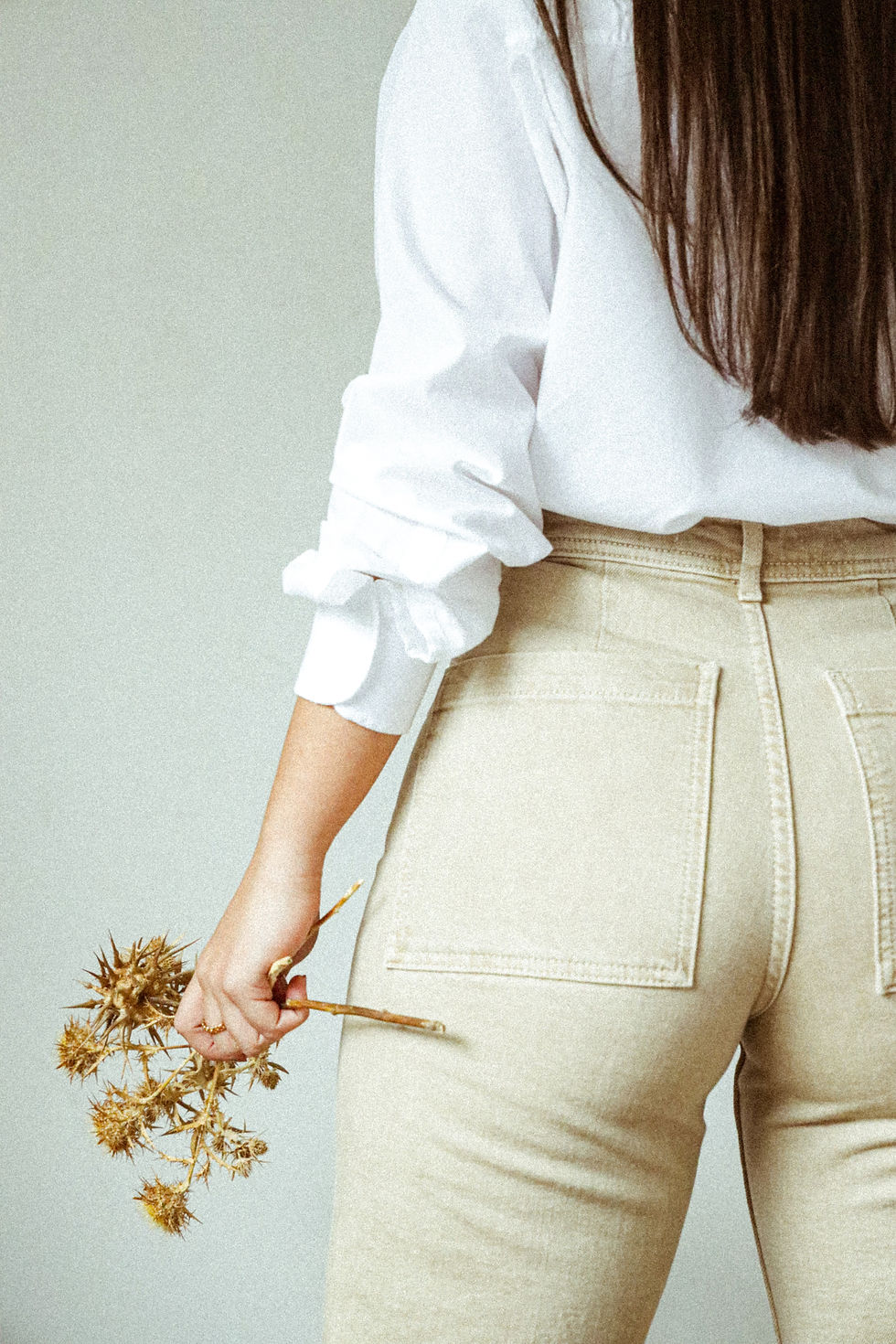EXPLORING LINEN: YOUR BRAND'S SUSTAINABLE FASHION SOLUTION
- Melissa

- Feb 1, 2024
- 7 min read
In today's fast-paced world, there is a growing need for industries to shift towards more sustainable practices, not least in the field of fashion. In our quest to find viable alternatives to environmentally harmful textiles, we've stumbled upon a gem: Linen. Today, we're going to delve deep into the world of linen, uncover its sustainability credentials, and understand why it could be the perfect fabric for your brand's eco-friendly collection.

The Basics of Linen Fabric
A treasure from the annals of history, linen is a natural, versatile fabric spun from the stalks of the flax plant. Its origins weave through the tapestry of human civilisation, making appearances in everything from the burial rituals of ancient Egypt to the masterpieces of Renaissance painters. In contemporary fashion, linen is coveted for its refreshing, lightweight properties and its distinctive weave that adds character to its texture. The fabric's adaptability is truly admirable, being a popular choice for not just clothing, but also bedding, upholstery, and table linens. Indeed, the essence of linen lies in its inherent simplicity, natural origins, and multi-faceted use across various domains.

How Linen Fabric is Produced
Creating linen fabric is an art. Let's take a scenic journey through the age-old method of linen production. It all begins with the sturdy flax plant, which goes through a unique process known as 'retting.' During retting, the plant is left to naturally decompose in water, gently breaking down the pectin that binds the fibres within the stalk.
When the retting process is just right, the fibres are separated from the plant stalks. This part of the process requires a skilled hand, as too much force can damage the fibres. The resulting flax fibres are then laid out to dry before the real transformation begins.
The dried fibres are subjected to 'scutching,' a method of beating the stalks to remove the woody part, and 'hackling,' or combing, to separate the shorter fibres from the desirable long fibres. These long, lustrous fibres are then spun into thread, undergoing a metamorphosis from simple plant material to a textile that’s ready to be woven into fabric.
The weaving process can either be done on large industrial looms or by hand for a more artisanal feel. The threads interlace with each other, creating the distinctive linen weave that we all know and love.
As a testament to its natural origins, the entire linen production process largely steers clear of harmful chemicals. However, it's worth noting that this process is not without effort. Each step is labour-intensive, requiring patience and craftsmanship. Yet, it's this very characteristic that sets linen apart from its synthetic counterparts. Each piece of linen fabric embodies a story of time, effort, and care - a narrative that is increasingly appealing in an era seeking authenticity and sustainability.
Despite being water-intensive, linen production can be balanced using rainwater or innovative water recycling methods, thus mitigating its overall environmental footprint. So, while linen may require more work to produce, its ecological benefits and enduring appeal make it a fabric truly worth investing in.

The Environmental Impact of Linen Production
Delving into the ecological implications of linen production, it becomes clear why this fabric has earned its eco-friendly badge. The flax plant, from which linen is derived, flourishes effortlessly in cool climates without the necessity of chemical-intensive fertilisers and pesticides. This characteristic considerably reduces the overall environmental load often associated with conventional farming methods.
One of the sterling aspects of flax cultivation is its propensity for waste minimisation. Virtually every part of the plant is utilised, meaning very little goes to waste during linen production. From seeds used for flax oil or livestock feed to the shives used in fibreboards or animal bedding, the humble flax plant is an epitome of zero-waste living.
However, it's crucial to address the elephant in the room – water consumption. While linen production is indeed water-intensive, specifically during the retting phase, this environmental cost is often offset. The retting process traditionally occurs in natural bodies of water, employing rainfall as a sustainable water source. Today, many linen producers are adopting innovative water recycling techniques, reusing water from the retting process, thereby significantly reducing the water footprint of linen.
All these factors combined demonstrate that while not entirely devoid of environmental implications, linen's eco-profile is significantly lighter than many other fabrics. Its production process champions sustainable farming practices, waste reduction, and ingenious resource management, all vital elements of an environmentally responsible textile industry. As we advance towards a more sustainable future, linen, with its earth-friendly production process, is poised to play a significant role in the transition.

The Longevity and Durability of Linen Clothing
Linen's impressive lifespan is a characteristic that greatly enhances its sustainability value. The natural fibres of linen are renowned for their robustness and endurance, meaning garments constructed from this material have the potential to be enjoyed for many years, even generations, with the right care.
Picture this: a piece of linen clothing that once belonged to a grandparent, passed down and cherished through the years, still retaining its beauty and quality. This is the magic of linen, a fabric that, much like a fine wine, improves with age.
Contrast this to the ephemeral nature of fast fashion items, which can be outgrown stylistically, physically, or lose their initial appeal after only a few uses. The lifespan of linen significantly outstrips such garments, proving its worth as a sound sartorial investment.
But it's not just about the financial aspect. The longevity of linen also means fewer resources are used over time to replace worn-out clothing. This reduces the demand for new textiles, subsequently lowering the impact on the environment.
Importantly, a linen garment's long life doesn't compromise its quality. Over time, instead of wearing out, linen becomes softer, more absorbent, and more comfortable to wear. The texture of the fabric evolves, developing a patina that adds character and depth, enhancing the garment's unique appeal.
The endurance of linen extends beyond just physical longevity. Linen clothing is timeless in style, often transcending seasonal trends. Its minimalist charm and natural aesthetic make it a versatile choice that can easily adapt to changing fashion trends, further ensuring its place in your wardrobe for years to come.
Investing in linen clothing, therefore, becomes not just a purchase, but a commitment to sustainability, quality, and timeless style. A commitment that pays off, not just for you, but for the planet too.

Linen’s Role in a Circular Economy
As we move towards an economy that values longevity, reusability, and sustainability, linen stands tall as a prime contender. In the circular fashion model, where resources are kept in productive use for as long as possible, linen slots in seamlessly. With its natural fibres, linen garments don't simply reach the end of their life – they begin a new cycle.
One of the key features of linen that allows it to play a substantial role in a circular economy is its biodegradability. When a linen garment has served its purpose, it doesn't need to become waste. Instead, it can be composted, breaking down into its natural elements and enriching the soil. It's almost poetic, the way the nutrients are returned to the earth, ready to support the growth of new life – perhaps even a new flax plant.
Alongside this, linen's robustness and longevity mean that it naturally reduces the need for frequent replacements. This characteristic fits perfectly into the "use and reuse" principle of a circular economy, where the focus is on extending the life of products. Garments made from linen have the potential to be loved, worn, and passed down through generations, which means fewer resources are required for the creation of new clothing items. It's a way of clothing production that respects the cycles of nature and minimises waste.
However, the role of linen in a circular economy doesn't stop at the consumer level. It extends back to its production process, which, as we've explored, is a model of resource efficiency and waste minimisation. With every part of the flax plant being utilised and innovative recycling methods being employed, linen production provides a blueprint for how we can create beautiful, useful products without placing undue strain on our planet's resources.
Linen's journey – from flax field to spinning wheel, from garment to compost heap – aligns well with the principles of a circular economy. It's a testament to how, with thoughtful design and responsible choices, we can cultivate an approach to fashion that values both style and sustainability. Indeed, embracing linen might just be one of the steps we can take towards a more circular, and therefore more sustainable, fashion future.

Linen’s Aesthetic and Sensory Appeal
Apart from its commendable eco-friendly credentials, linen also shines through with its distinctive aesthetic allure and sensory charm. The fabric's raw, earthy look imparts an organic vibe to every design, marking it as an essential ingredient for creating effortlessly chic ensembles. Linen has a unique knack for staying cool to the touch, a feature that becomes incredibly appealing in sultry climates or during the sweltering summer months. This is combined with the fabric's exceptional breathability, ensuring that linen clothing keeps you comfortable, even on the warmest of days.
An interesting trait of linen is that it improves with use and age. The more it's worn and washed, the softer and more inviting it becomes, without any compromise on its longevity or durability. This sensory transformation enhances the tactile appeal of linen, making your clothing feel like a cherished old friend that only gets better with time.
The adaptability of linen is truly remarkable. It effortlessly transitions from casual to elegant, from daytime to evening, from season to season. Its understated elegance lends itself beautifully to a plethora of styles, making it a versatile player in your brand's collection. Whether it's a breezy summer dress, a sophisticated shirt, or a pair of comfortable loungewear trousers, linen has the potential to redefine each piece with its distinctive charm.
When it comes to integrating linen into your fashion line, the opportunities are as wide as your creativity allows. Mix and match with other fabrics, play with the natural colour palette of linen, or experiment with various weaves - the fabric is a playground for designers seeking to make a sustainable and stylish impact.
In conclusion, linen is more than just a fabric; it's a sensory experience. Its appeal lies not just in its visual charm, but also in the way it feels against the skin, the way it drapes, and the way it ages beautifully. By choosing linen, your brand isn't just opting for sustainability, but also embracing a textile that offers a unique aesthetic and sensory experience.



